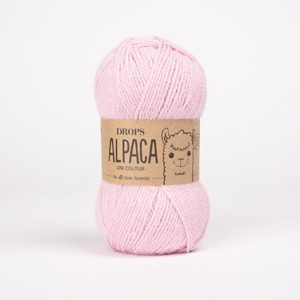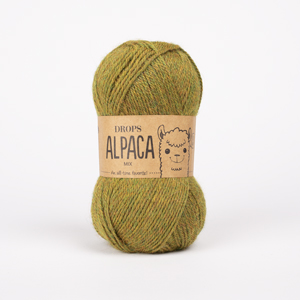Comments / Questions (11)
![]() Rika wrote:
Rika wrote:
Moet het hele slofje in structuurpatroon?
07.12.2021 - 10:40DROPS Design answered:
Dag Rika,
Als je het patroon volgt komt er een 'structuur' bovenop de slof, alle toeren zijn uitgeschreven..
07.12.2021 - 17:04
![]() Pernilla wrote:
Pernilla wrote:
Vad menar ni med "OBS: Det virkas i varje m (inte mellan m)" vid virkning av sulan? Ska det enbart virkas i yttre maskbågen?
25.10.2019 - 16:31DROPS Design answered:
Hei Pernilla. Det er bare en OBS på at man skal hekles i masken (vanlig hekling/ i begge maskebuene) og ikke mellom 2 masker. God Fornøyelse!
28.10.2019 - 11:14
![]() TRICOT wrote:
TRICOT wrote:
Est-ce possible d'avoir le diagramme pour de modèle ? , je n'arrive pas bien à suivre les explication ... merci
27.02.2018 - 15:48DROPS Design answered:
Bonjour Mme Tricot, nous n'avons pas de diagramme pour ce type de modèles, suivez bien pas à pas les explications et n'hésitez pas à poser votre question ici si besoin. Pour toute assistance individuelle, vous pouvez également vous adresser auprès de votre magasin. Bon crochet!
27.02.2018 - 16:21
![]() Elin Ignell wrote:
Elin Ignell wrote:
Är fundersam på stolekarna. När jag virkar en kedja med 24 fm så kommer jag inte upp i 10 cm ens med nål 5 och då har jag verkligen inte virkat tajt. Det förvirrar mig ytterligare att storlek 1/3 månader, enligt beskrivningen ska mäta 10 cm. Men antalet maskor där sulan är som längst är 17. Så hur kan detta gå ihop, om 24 fm nu ska ge mig 10 cm förutsatt att jag valt rätt virknål? Tacksam för vägledning :) MVH Elin
05.11.2017 - 16:38DROPS Design answered:
Hej Elin, virkar du i DROPS Alpaca? Då skall du få 24 fm på 10 cm. Om du får virkfastheten till at stämma, så vill även måtten stämma enligt mönstret. Testa med sulan först får du se :)
16.11.2017 - 09:25
![]() Nina wrote:
Nina wrote:
Jeg har 38 staver nå, lurer på neste omgang der jeg skal felle 1 stav ved 2 hjørnene foran på tåen. Skal det hekles staver hele runden eller bare mellom de 2 hjørnene?
09.08.2017 - 17:24DROPS Design answered:
Hei Nina. Det skal hekle 1 stav i hver stat hele runden, men fell 1 stav i hvert av de 2 hjørnene foran på tåen. God Fornøyelse!
14.08.2017 - 16:29
![]() Charlotte Goonan wrote:
Charlotte Goonan wrote:
I'm working this in size 6/9 months, what do the numbers in brackets after mean e.g. (26-29)? Also - the pattern refers to rounds to crochet if you're making size 2 years + 3/4 years but there isn't a size for this, the pattern says size 12/18 months is 2 - 3/4 years. I'm not clear if this means to do that round if you're doing the 6/9 months like I am. I assume I have to do the fifth round for 3/4 years. Please help!
28.03.2017 - 01:07DROPS Design answered:
Dear Charlotte, the numbers in brackets refer to the sizes that would suit 2 years old and 3-4 years old children.If you are working the size that would fit a 6/9 month old child, you should work until round 3, then skip to the next row that says it is for all sizes. I hope this helps. Happy crocheting!
28.03.2017 - 01:16Tamara wrote:
Very beautiful pattern, thank you very much! Could it be that the last 12 lines for the border should be with sc, rather than dc as per the instruction?
01.02.2016 - 00:00DROPS Design answered:
Dear Tamara, that's correct, the last 12 rounds are worked with sc - remember that US-English and UK-English do have different crochet terminology, you can edit the language of the pattern by selecting correct language under the picture - read more here. Happy crocheting!
01.02.2016 - 10:56Sahera wrote:
Hi, i dont really get what the numbers in the pattern are for when they appear in series like 1-1-2-2 and so on. Could you please help me out with this? Regards
26.06.2015 - 13:07DROPS Design answered:
Dear Sahera, each number refers to each size, ie "Work 12-14-16-19 (25-28) ch" ... means in first size work 12 ch, in 2nd size work 14 ch, in 3rd size work 16 ch and so on. Happy crocheting!
26.06.2015 - 18:38Lourdes González wrote:
Hermoso el escarpín ! Muy fácil de hacer. Agradezco mucho a quienes hacen este sitio porque me incentivan a hacer cosas que son mi distracción en los quehaceres diarios. Me emociona mucho cuando termino una prenda y se vé igual que la foto que publicaron. Un Abrazo!
24.06.2015 - 04:49Rebeca wrote:
Hermosos, una calidad fina y excelente
25.08.2014 - 18:14
Baby Steps#babystepsbooties |
|
|
|
|
Crochet baby slippers in DROPS Alpaca. Size 0 - 4 years.
DROPS Baby 25-20 |
|
|
CROCHET INFO: Replace first sc at beg of every sc round/row with 1 ch. Finish round with 1 sl st in ch from beg of round. Finish row with 1 sc in 3rd ch from beg of previous row. Replace first dc at beg of every dc round/row with 3 ch. Finish round with 1 sl st in 3rd ch from beg of round. Finish row with 1 dc in ch from beg of previous row. INCREASE TIP: Inc 1 sc/dc by working 2 sc/dc in same st. DECREASE TIP: Work 1 sc/dc but wait with last pull through (= 2 sts on hook), then work next sc/dc but on last pull through, pull yarn through all sts on hook = 1 sc/dc dec. CROCHET TIP: On the round after dc at the front of slipper have been worked tog 2 by 2, work somewhat tightly at the front of slipper, i.e. tighten the yarn a little between every dc when working. This is done to avoid a loose mid piece at the front of slipper. TEXTURE ROWS: * 1 row sc (worked from WS), 1 row dc (worked from RS) *, repeat from *-* (1 row sc + 1 row dc = 1 texture row). ---------------------------------------------------------- SLIPPER: READ CROCHET INFO and beg with sole - NOTE: Work in every st (not between sts). Ch 12-14-16-19 (25-28) (includes 1 ch to turn with) on hook size 3 mm with light steel blue. Work first row as follows: 1 sc in 2nd ch from hook, 1 sc in each of the next 10-12-14-17 (23-26) ch = 11-13-15-18 (24-27) sc, turn piece. Then work 1 sc in every sc from previous row while AT THE SAME TIME inc 2 sc at beg and end of first row by working 3 sc in first and last sc on row = 15-17-19-22 (28-31) sc. Work sc back and forth until 1 row remains before piece measures 3-3-4-4 (4½-5) cm / 1"-1"-1½"-1½" (1 3/4"-2"). Now dec 2 sc in each side - READ DECREASE TIP = 11-13-15-18 (24-27) sc on row – NOTE: At the end of row beg dec when 4 sc remain, then work the last 4 sc tog 2 by 2. Piece measures approx. 3-3-4-4 (4½-5) cm / 1"-1"-1½"-1½" (1 3/4"-2"). Fasten off. Then work dc around the sole as follows: ROUND 1: Beg mid back (= mid of one short side) - Work 1 sc in first st, 3 ch (= 1 dc), work 1-1-2-2 (3-3) dc until corner, 2 dc in the corner, 1 dc in each of the 11-13-15-18 (24-27) sc along the side, 2 dc in the corner, 4-4-6-6 (8-8) dc along short side (= toe), 2 dc in the corner, 11-13-15-18 (24-27) dc along the side, 2 dc in the corner and 2-2-3-3 (4-4) dc along short side until mid back, finish with 1 sl st in 3rd ch from beg of round = 38-42-50-56 (72-78) dc. NEXT ROUND IN SIZE 2 YEARS + 3/4 YEARS (do not work this round in the other sizes): Work 1 round with 1 dc in every dc = (72-78) dc. WORK NEXT ROUND AS FOLLOWS IN ALL SIZES: Work 1 dc in every dc but dec 1 dc in each of the 2 corners at the front on toe – READ DECREASE TIP = 36-40-48-54 (70-76) dc. THEN WORK AS FOLLOWS FROM MID BACK (work 1 st in every st from previous round): ROUND 1: 12-14-17-20 (27-30) sc, 1 hdc, work 2 dc tog – READ DECREASE TIP, 6-6-8-8 (10-10) dc, work 2 dc tog, 1 hdc and 12-14-17-20 (27-30) sc = 34-38-46-52 (68-74) sts. ROUND 2: 11-13-16-19 (26-29) sc, 1 hdc, work 2 dc tog, 6-6-8-8 (10-10) dc, work 2 dc tog, 1 hdc and 11-13-16-19 (26-29) sc = 32-36-44-50 (66-72) sts. ROUND 3: 10-12-15-18 (25-28) sc, 1 hdc, work 2 dc tog, 6-6-8-8 (10-10) dc, work 2 dc tog, 1 hdc and 10-12-15-18 (25-28) sc = 30-34-42-48 (64-70) sts. 4TH ROUND IN SIZE 2 YEARS + 3/4 YEARS (do not work this round in the other sizes): (24-27) sc, 1 hdc, work 2 dc tog, (10-10) dc, work 2 dc tog, 1 hdc and (24-27) sc = (62-68) sts. 5TH ROUND IN SIZE 3/4 YEARS (do not work this round in the other sizes): (26) sc, 1 hdc, work 2 dc tog, (10) dc, work 2 dc tog, 1 hdc and (26) sc = (66) sts. WORK NEXT ROUND AS FOLLOWS IN ALL SIZES: 9-11-14-17 (23-25) sc, 1 hdc, work the next 10-10-12-12 (14-14) dc tog 2 by 2, 1 hdc and 9-11-14-17 (23-25) sc = 25-29-36-42 (55-59) sts. WORK NEXT ROUND AS FOLLOWS IN ALL SIZES: READ CROCHET TIP and work 7-9-12-15 (21-23) sc, 1 hdc, work 2 dc tog, 5-5-6-6 (7-7) dc, work 2 dc tog, 1 hdc and 7-9-12-15 (21-23) sc = 23-27-34-40 (53-57) sts. WORK NEXT ROUND IN SIZE 2 YEARS + 3/4 YEARS AS FOLLOWS (do not work this round in the other sizes): (20-21) sc, 1 hdc, work 2 dc tog, (7-7) dc, work 2 dc tog, 1 hdc and (20-21) sc = (51-55) sts. ALL SIZES: = 23-27-34-40 (51-55) sts. Work 1-1-1-2 (2-3) rounds with 1 dc in every st while AT THE SAME TIME adjusting no of sts to 24-24-30-30 (36-36) dc on 1st round - READ INCREASE TIP/DECREASE TIP - NOTE: If you want a slipper with a larger opening, adjust no of sts to desired measurements. FOLDING EDGE: Switch to off white and work 1 round sc with 1 sc in every st. Work 12 rounds in total with sc. Fasten off. |
|
Have you finished this pattern?Tag your pictures with #dropspattern #babystepsbooties or submit them to the #dropsfan gallery. Do you need help with this pattern?You'll find 11 tutorial videos, a Comments/Questions area and more by visiting the pattern on garnstudio.com. © 1982-2025 DROPS Design A/S. We reserve all rights. This document, including all its sub-sections, has copyrights. Read more about what you can do with our patterns at the bottom of each pattern on our site. |












































Post a comment to pattern DROPS Baby 25-20
We would love to hear what you have to say about this pattern!
If you want to leave a question, please make sure you select the correct category in the form below, to speed up the answering process. Required fields are marked *.